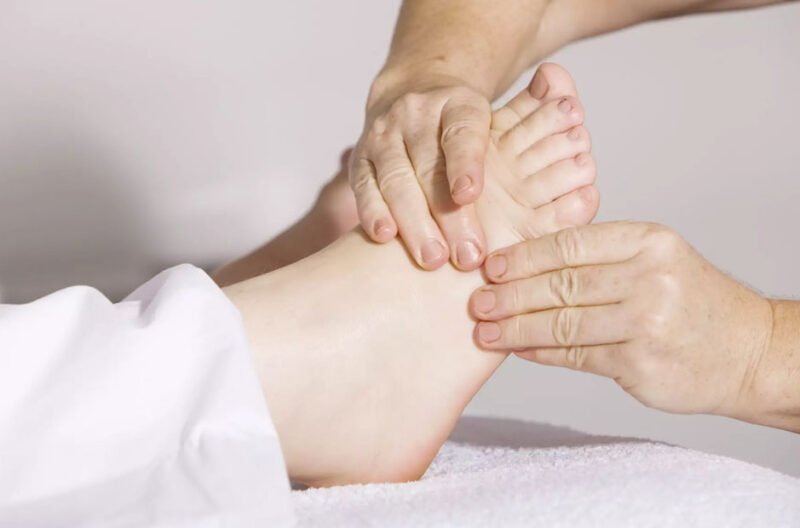People with diabetes are at risk of foot infections, ulcerations, and possible amputations. Educational programs are effective interventions that teach patients how to help prevent foot conditions, rather than being passive recipients of care. This enables individuals to acquire the necessary skills to conduct daily foot inspections and identify problems early. Here are some benefits of diabetic foot care education for patients:
Prevents Foot Ulcers and Wounds
A key element of orthopedic foot care is completing regular inspections that examine all surfaces of the feet. Minor lesions should be monitored closely, but infections require prompt attention. Education programs help patients recognize early warning signs and symptoms, such as:
- Minor cuts
- Blisters
- Abnormal discoloration
- Redness
- Warmth
- Swelling
- Tenderness
Patients also learn to use mirrors to inspect difficult-to-reach areas, such as the soles of their feet and the space between their toes. Training sessions emphasize the benefits of being aware of foreign objects, including pebbles or splinters that may be embedded in the skin. These irritants may lead to open wounds or infections that need immediate attention. Education also involves providing guidance on how to identify changes in skin texture, such as areas that appear abnormally dry, cracked, or calloused. Documenting any changes in the foot’s appearance can help an individual monitor their condition and effectively inform healthcare professionals of any issues.
Lowers Chances of Amputation
Educational programs inform patients about the potential for minor injuries to quickly develop into serious infections. The basics of wound care are taught during training, such as how to clean a wound and how to dress a small cut or abrasion. Patients learn to recognize the signs of infection, including increased drainage, a foul odor, or redness spreading from wounds. Education should emphasize the role of prompt medical attention before issues escalate to safety or health risks. Footwear selection programs help patients choose shoes that prevent injuries and reduce pressure and friction-related issues. Training involves instructions on nail care methods, the avoidance of ingrown toenails, and other common causes of infection and ulceration. Patients learn how circulation issues affect the healing process, and they understand why even minor injuries require attention and care.
Better Blood Sugar Control
Diabetic foot care education establishes strong associations between day-to-day diabetic foot care and general glucose management plans. Training addresses the connection between glucose levels and vulnerability to infections, specifically those affecting foot tissues. Patients learn effective diabetes management techniques to maintain healthy blood circulation, which provides the feet with the necessary nutrients and oxygen. Education focuses on monitoring strategies, such as frequent blood glucose checks and identifying patterns that influence foot health.
Patients should be taught about lifestyle factors, including diet, physical activity, and stress management, which can affect both conditions. They learn how foot issues can exacerbate blood sugar levels, leading to risky cycles of complications and regression. Some educational sessions incorporate goal-setting strategies that enable individuals to establish realistic objectives for managing glucose levels and foot care, sometimes with the support of natural aids like berberine (available at:https://lumanutrition.com/products/berberine), to help maintain metabolic balance.
Improved Living and Movement
Education helps patients retain their independence by enabling them to walk, exercise, and be active. Preventive measures help maintain healthy feet and enable diabetic patients to participate effectively in work, recreation, and social activities. Patients are educated on adaptive mechanisms for sustaining active lifestyles, including selecting the right activities and monitoring intensity levels.
Education involves footwear choices for various activities, such as work boots, athletic shoes, and dress shoes, which provide key support. Physical therapy or daily exercises aim to improve balance and mobility, strengthening the feet and lower legs. This helps lessen the likelihood of falls. Some exercises also stimulate blood flow without causing injury to the feet or trauma. Patients learn to adapt to activities when issues arise and remain engaged, while still allowing for adequate healing and recovery.
Seek Diabetic Foot Care
Diabetic foot care education is a key intervention that offers transformative effects for various health aspects. These educational programs extend beyond foot health and support the overall management of diabetes. Maintaining foot and ankle health helps support continued independence and a high quality of life. Foot specialists help manage and treat minor to severe foot health concerns. Begin the process of improving your foot health by consulting your medical practitioner about the benefits of diabetic foot care education today.






